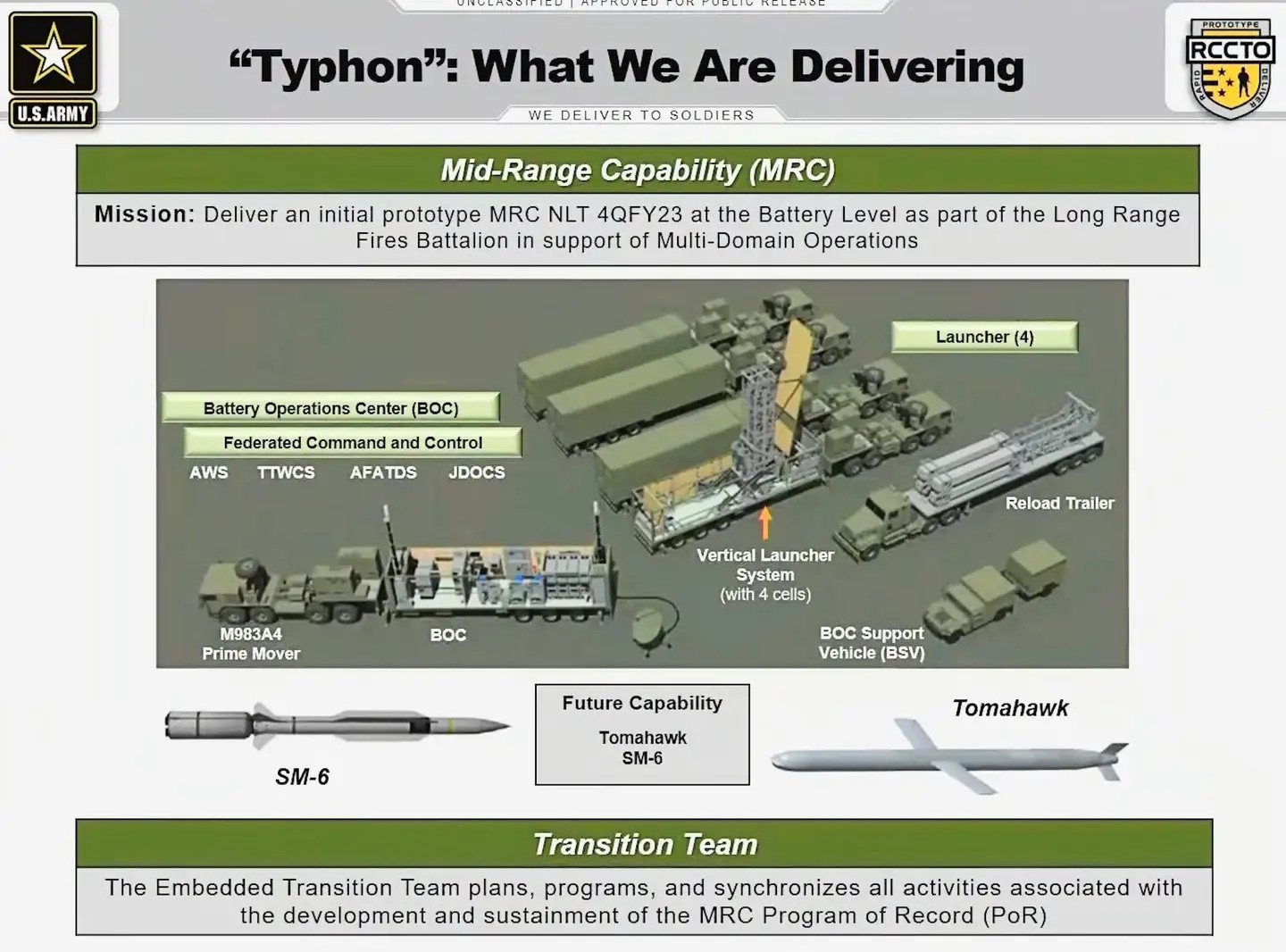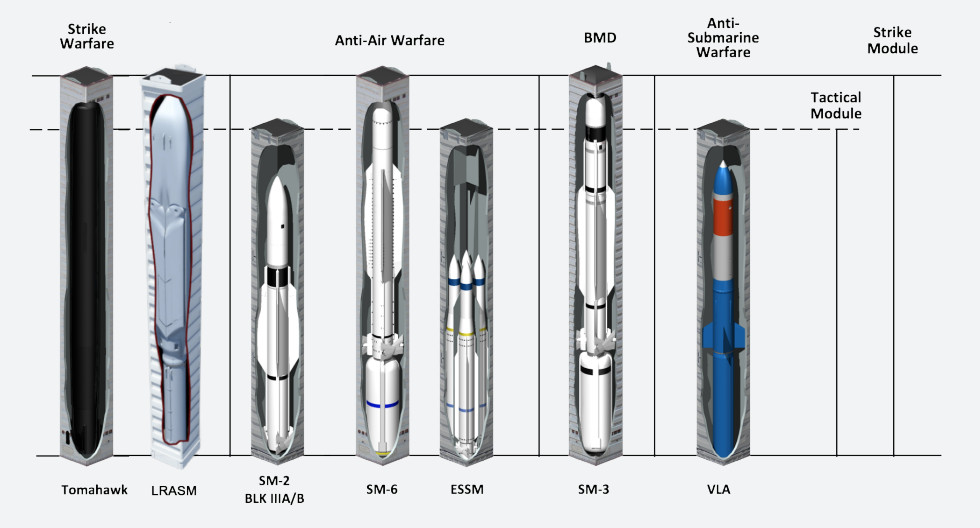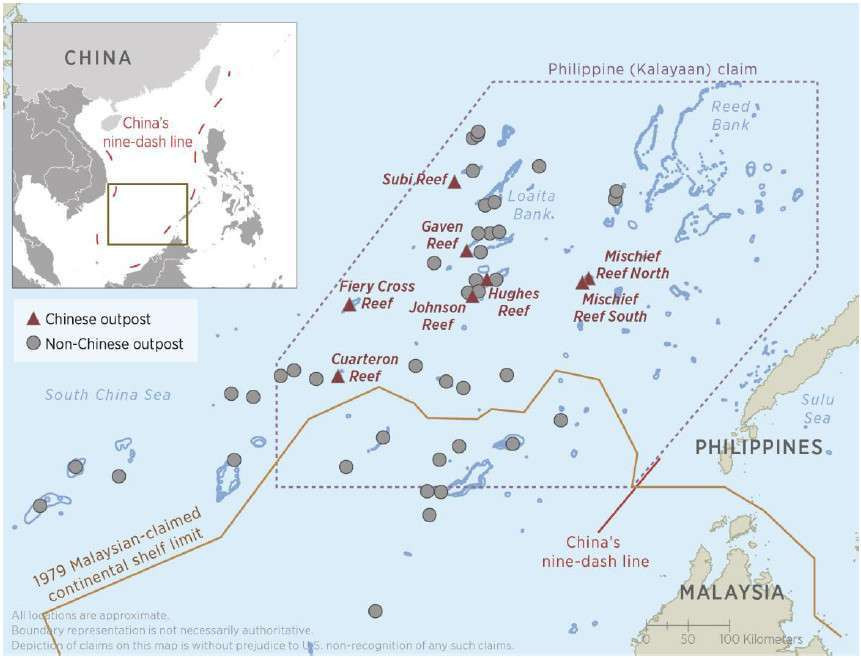The U.S. Army says it has demonstrated the operational capability of its newest ground-based missile launcher with the system’s recent successful firing of a Tomahawk land-attack cruise missile. This follows a test launch of a multi-purpose SM-6 missile earlier this year from what is officially known as the Typhon Weapon System. The service currently has one so-called Mid-Range Capability battery equipped with Typhon, which has four trailer-based launchers and other supporting equipment.
The Army’s Rapid Capabilities and Critical Technologies Office (RCCTO) announced the Tomahawk launch on June 28, but the actual test had occurred the day before. This comes just over six months after the service accepted delivery of the first Typhon launchers and other components of its first Mid-Range Capability (MRC) battery from Lockheed Martin.

“This test follows the successful launch of an SM-6 missile from the Mid-Range Capability system earlier this year, confirming the full operational capability of the system,” according to a brief statement from RCCTO.
Army officials have said in the past that their goal is to reach at least some level of true operational capability with the first MRC battery before the end of Fiscal Year 2023 this September.
A complete Typhon Weapon System battery consists of four launchers and a command post, all on trailers, as well as reload and support vehicles, according to details the Army has released in the past. Targeting information is provided by offboard sources.

The Army currently expects Typhon to be employed primarily against land-based targets using either Tomahawk or SM-6. At the same time, anti-ship optimized variants of Tomahawk exist. Originally designed as a surface-to-air missile, SM-6 has a demonstrated anti-ship capability, too, and significantly longer-range and otherwise more capable versions are in development. As it stands now, the U.S. military says that the SM-6 family is its only real capability for engaging incoming highly-maneuverable hypersonic weapons.

Altogether, the door is already wide open to the possibility of future Army MRC batteries being employed against a wide variety of targets in the future. These same launchers are already expected to be part of the expanded air and missile defenses that the U.S. military is working to put in place on the strategic U.S. island territory of Guam.
In addition, the Typhon launchers are derived from the Mk 41 Vertical Launch System (VLS) in use on various U.S. Navy and foreign warships. This launcher can already fire a wide array of containerized missiles, and other types could be integrated into it in the future.

RCCTO said that personnel from the 1st Multi-Domain Task Force, headquartered at Joint Base Lewis-McChord in Washington State, had conducted the test launch with support from the U.S. Navy’s Program Executive Office for Unmanned Aviation and Strike Weapons (PEO U&W). The Navy is the lead service responsible for managing the Tomahawk and SM-6 missile programs across the U.S. military.
Furthermore, on top of the Mk 41-based launchers, Typhon has a fire control system derived from the combat-proven Aegis Combat System. The Mk 41 VLS and Aegis are also Navy-managed programs. The Navy itself has been testing a containerized Mk 41-derived launcher called the Mk 70 Expeditionary Launcher, which is very similar to the Typhon design. Variants and/or derivatives of the Mk 70 have been embarked on uncrewed ships and loaded on trailers.

The Army and the Navy have both been working closely with the Marines, which is acquiring its own ground-based Tomahawk capability, as you can read more about here “All three Services share common fire control, missile launcher canisters, and missiles,” a Marine Corps spokesperson told The War Zone in June. The Marines’ currently plan to use a smaller remotely-operated launcher based on the 4×4 Joint Light Tactical Vehicle (JLTV), but there are questions about the feasibility of that combination.
For the Army, specifically, the successful demonstration of Typhon’s full expected operational capability is another important step forward in the service’s efforts to field a number of new long-range strike capabilities. This also includes the Dark Eagle Long-Range Hypersonic Weapon (LRHW) and the Precision Strike Missile (PrSM) short-range ballistic missile. PrSM can be fired from existing M270 Multiple Launch Rocket System (MLRS) and M142 High-Mobility Artillery Rocket System (HIMARS) launchers and the Army is now looking into even longer-range missiles that might work with those systems.

Armed with Tomahawk, Typhon gives the Army a new tool that allows it to create a bubble that extends roughly 1,000 miles in all directions from wherever the launchers within which it can hold land-based targets at risk. The shorter-range SM-6 gives the complete system further flexibility. As already noted, the ability of Tomahawk and SM-6 to engage other kinds of targets means that an MRC battery could have broader anti-access/aerial denial functionality in the future.
With the Navy and Marine Corps programs’ ground-based Tomahawk programs moving forward, Typhon is also part of a new and larger joint-service land-based long-range strike ecosystem that is emerging. This is being heavily driven by the U.S. military’s desire for more options for hitting targets on land, at sea, and in the air across the vast expanses of the Indo-Pacific region in any future higher-end conflict, especially one against China.
U.S. officials, as well as independent experts, regularly draw attention to China’s People’s Liberation Army’s (PLA) numerical superiority in conventionally-armed ground-based cruise and ballistic missiles. This gives the PLA significant anti-access and aerial denial capabilities in various strategic regions, including the hotly contested South China Sea, as well as a significant non-nuclear deterrent more generally.

At the same time, questions do remain about exactly where land-based systems like Typhon could be deployed, particularly in the Indo-Pacific. The governments of many U.S. allies and partners have publicly stated that they are not interested in hosting American ground-launched long-range strike capabilities.
These new long-range-strike capabilities could be deployed in response to conflicts and crises elsewhere, too. In 2021, the Army stood up the 56th Artillery Command in Germany specifically to serve as a forward command and control node for future long-range “fires” units. The previous iteration of this unit had overseen Army Pershing and Pershing II nuclear-armed ballistic missiles during the Cold War in Europe.
It’s also worth noting that the U.S. Air Force fielded ground-launched nuclear-tipped Tomahawk variants, called BGM-109G Gryphons, in Europe between 1983 and 1991. The Army, Navy, and Marine Corps’ new land-based long-range missile systems will all be conventionally armed.

No matter how the Army’s plans for deploying and employing its future MRC batteries continue to evolve, the service, alongside the Navy and Marines, is continuing to make progress in turning this capability into an operational reality.
Contact the author: joe@thedrive.com
